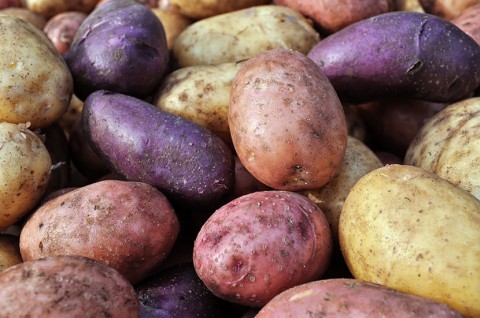DrCarney.com Blog
What's for Passover? Potatoes?
Vegans and others following a plant-based diet may face challenges during the seven days of Passover. If they are from the Ashkenazic tradition of Judaism, not only is leavening prohibited, but chametz (wheat, oats, rye, barley, and spelt) and kitniyot (all legumes including green beans, plus rice, corn, millet, and many other seeds) are also avoided. Omnivores navigate these restrictions by enjoying the foods which are permitted; meals traditionally rely heavily on eggs, dairy, and meat. But those on a plant-based diet may be concerned because many of their usual sources of calorie dense starches are banned.
A remarkable story from history might alleviate fears of hunger or flagging energy for Passover plant-eaters. John McDougall, MD, relates the story of the nation of Denmark which not only survived but thrived during World War I by eating a starch-based diet that relied strongly on potatoes. The British navy blockaded the ports of the North Sea during WWI, resulting in the death from malnutrition of over 400,000 Germans between 1914 - 1918. Denmark remained neutral during the war, but the Nordic country was also affected by the blockade. However, due to the work of a brilliant physician and nutritionist, Mikkel Hindhede (1862-1945), the Danes actually reported fewer deaths during the most severe year of famine, 1917-1918, than they had even in the years before the war.
Thriving on Potatoes in Denmark
Dr. Hindhede served as the manager of the Danish National Laboratory for Nutrition Research in Copenhagen and food advisor to the Danish government during WWI. Based on his advice, the country of Denmark switched from a diet rich in meat to a diet that relied on starchy grains and vegetables. Most of the country's pigs were sold and the county's cattle population was reduced by a third. The country also limited alcohol production. These measures freed up the country's grain supply in order to feed the populace. At the end of the war, Dr. Hindhede wrote, "As research has also shown that man can retain full vigor for a year or longer on a diet of potatoes and fat and for half a year or more on a diet of barley and fat, reliance was placed on our potatoes and the large barley crop, which was given to man and not to the pigs, as heretofore, with the result that the pigs died of starvation, but the people received sufficient nutrition.”
When asked if he was surprised by how healthy the Danes were at the end of the years of war privations, Dr. Hindhede replied, "This result was not a surprising one to me. Since 1885, when I began my experiments with a low-protein diet (mostly vegetarian), I have been convinced that better physical conditions resulted from this standard of living...As the result of extensive studies in this field I am convinced that over-nutrition, the result of palatable meat dishes, is one of the most common causes of disease.” He stated that if the rest of central Europe had adopted measures similar to those adopted in Denmark, he doubted that anyone would have starved during the war.
The Outstanding Nutrition of Potatoes
According to Dr. McDougall, "Potatoes can provide complete nutrition for children and adults. Many populations, for example people in rural populations of Poland and Russia at the turn of the 19th century, have lived in very good health doing extremely hard work with the white potato serving as their primary source of nutrition." He gives further evidence for the sufficiency of a potato diet by relating the experience of malnourished children in Peru:
The potato is such a great source of nutrition that it can supply all of the essential protein and amino acids for young children in times of food shortage. Eleven Peruvian children, ages 8 months to 35 months, recovering from malnutrition, were fed diets where all of the protein and 75% of the calories came from potatoes. (Soybean-cottonseed oils and pure simple sugars, neither of which contain protein, vitamins, or minerals, provided some of the extra calories.) Studies during the experimental feeding showed this simple diet provided all the protein and essential amino acids to meet the needs of growing and small children.
If growing children can recover from illness by eating primarily potatoes, there's no reason for us to panic this Passover. Even with the temporary absence of legumes, grains, and seeds on our plate, plants can provide optimal nutrition that will give us the nutrients and energy to enjoy this season with family and friends. Potatoes can power us through Passover and straight into optimizing our health. Chag Pesach Semeach!
For additional reading:
(1) Lessons from the Past, Directions for the Future: The WWI Starch Solution for Denmark
(2) Potatoes are the Pillar of World Wide Nutrition
(3) What to Make for Passover Seder? from "Healthy Girl's Kitchen"
(4) Anti-Inflammatory Effects of Purple Potatoes
(5) What is the Healthiest Potato?
Scroll Down Page to Leave Comments

Got Questions?
We would love to receive your questions. Join in the Starch-Smart Discussions on DrCarney.com by signing up for a free membership to the Dr. Carney Community.
Preview the "Ask the Doc!" Trailer
Your Questions Answered: In Dr. Carney's Starch-Smart® System seminars, written questions from participants are collected beforehand, protecting their privacy. In this informative video presentation, Dr. Carney shares the answer to many of those frequently asked questions - with complex scientific evidence made easy to understand. Learn the answers to what you've always wanted to ask, and so much more!
When you subscribe to the blog, we will send you an e-mail when there are new updates on the site so you wouldn't miss them.




